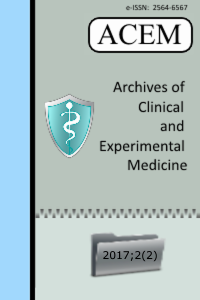Abstract
In 1945 Broch & Purcell described as Nuclear Magnetic Resonance. It was
used for chemical and biochemical analyses for long years. It was widely
used in medical applications after Lauterbur et al. ‘s study in 1973 (1).
The primary screening method for breast cancer is mammography as
known. It is the only method that positively affects survival. But its
sensitivity and specificity is not 100% and it can be an inadequate method
at some ages. Studies showed that: MRI imaging added mammography
increased success rates but increased false positivity rates can cause some
unnecessary invasive procedures. Although these breast MRI is widely used
for screening, diagnosis and staging (2).
More than 80 million MRI is worldwide applied yearly. Claustrophobia rates
are between 1-15% and more than 2 million breast MRI application is
interrupted for the necessitation of sedation (3). Melendez et al. noticed
that rate around 30%. Also 3-5% of these cases were interrupted due to
the sedation necessitation. Anxiety and claustrophobia can cause sequence
repeating, procedure cancellation and important time and labor loss.
Keywords
References
- 1. Bloch F, Hansen WW, Packard M. Nuclear induction. Phys Rev 1946;69:127.
- 2. Menon DK, Peden CJ, Hall AS, Sargentoni J, Whitwam JG. Magnetic resonance for the anaesthetist. Part I: Physical principles, applications, safety aspects. Anaesthesia. 1992 Mar;47(3):240-55. Review.
- 3. Health Quality Ontario. Magnetic Resonance Imaging as an Adjunct to Mammography for Breast Cancer Screening in Women at Less Than High Risk for Breast Cancer: A Health Technology Assessment. Ont Health Technol Assess Ser. 2016 Nov 1;16(20):1-30. eCollection 2016.
- 4. Enders J, Zimmermann E, Rief M, Martus P, Klingebiel R, Asbach P, Klessen C, Diederichs G, Bengner T, Teichgräber U, Hamm B, Dewey M. Reduction of claustrophobia during magnetic resonance imaging: methods and design of the "CLAUSTRO" randomized controlled trial. BMC Med Imaging. 2011 Feb 10;11:4. doi: 10.1186/1471-2342-11-4.
- 5. Meléndez JC1, McCrank E. Anxiety-related reactions associated with magnetic resonance imaging examinations. JAMA 1993;270:745-7.
- 6. Munn Z, Jordan Z. Interventions to reduce anxiety, distress and the need for sedation in adult patients undergoing magnetic resonance imaging: a systematic review. Int J Evid Based Healthc. 2013 Dec;11(4):265-74. doi: 10.1111/1744-1609.12045.
- 7. Barnea-Goraly N, Weinzimer SA, Ruedy KJ, Mauras N, Beck RW, Marzelli MJ, et al. High success rates of sedation-free brain MRI scanning in young children using simple subject preparation protocols with and without a commercial mock scanner–the Diabetes Research in Children Network (DirecNet) experience. Pediatr Radiol 2014;44:181–6.
- 8. Metzner J, Posner KL, Lam MS, Domino KB. Closed claims' analysis. Best Pract Res Clin Anaesthesiol 2011;25:263-76.
Abstract
References
- 1. Bloch F, Hansen WW, Packard M. Nuclear induction. Phys Rev 1946;69:127.
- 2. Menon DK, Peden CJ, Hall AS, Sargentoni J, Whitwam JG. Magnetic resonance for the anaesthetist. Part I: Physical principles, applications, safety aspects. Anaesthesia. 1992 Mar;47(3):240-55. Review.
- 3. Health Quality Ontario. Magnetic Resonance Imaging as an Adjunct to Mammography for Breast Cancer Screening in Women at Less Than High Risk for Breast Cancer: A Health Technology Assessment. Ont Health Technol Assess Ser. 2016 Nov 1;16(20):1-30. eCollection 2016.
- 4. Enders J, Zimmermann E, Rief M, Martus P, Klingebiel R, Asbach P, Klessen C, Diederichs G, Bengner T, Teichgräber U, Hamm B, Dewey M. Reduction of claustrophobia during magnetic resonance imaging: methods and design of the "CLAUSTRO" randomized controlled trial. BMC Med Imaging. 2011 Feb 10;11:4. doi: 10.1186/1471-2342-11-4.
- 5. Meléndez JC1, McCrank E. Anxiety-related reactions associated with magnetic resonance imaging examinations. JAMA 1993;270:745-7.
- 6. Munn Z, Jordan Z. Interventions to reduce anxiety, distress and the need for sedation in adult patients undergoing magnetic resonance imaging: a systematic review. Int J Evid Based Healthc. 2013 Dec;11(4):265-74. doi: 10.1111/1744-1609.12045.
- 7. Barnea-Goraly N, Weinzimer SA, Ruedy KJ, Mauras N, Beck RW, Marzelli MJ, et al. High success rates of sedation-free brain MRI scanning in young children using simple subject preparation protocols with and without a commercial mock scanner–the Diabetes Research in Children Network (DirecNet) experience. Pediatr Radiol 2014;44:181–6.
- 8. Metzner J, Posner KL, Lam MS, Domino KB. Closed claims' analysis. Best Pract Res Clin Anaesthesiol 2011;25:263-76.
Details
| Subjects | Clinical Sciences |
|---|---|
| Journal Section | Letter to Editor |
| Authors | |
| Publication Date | August 15, 2017 |
| Published in Issue | Year 2017 Volume: 2 Issue: 2 |

